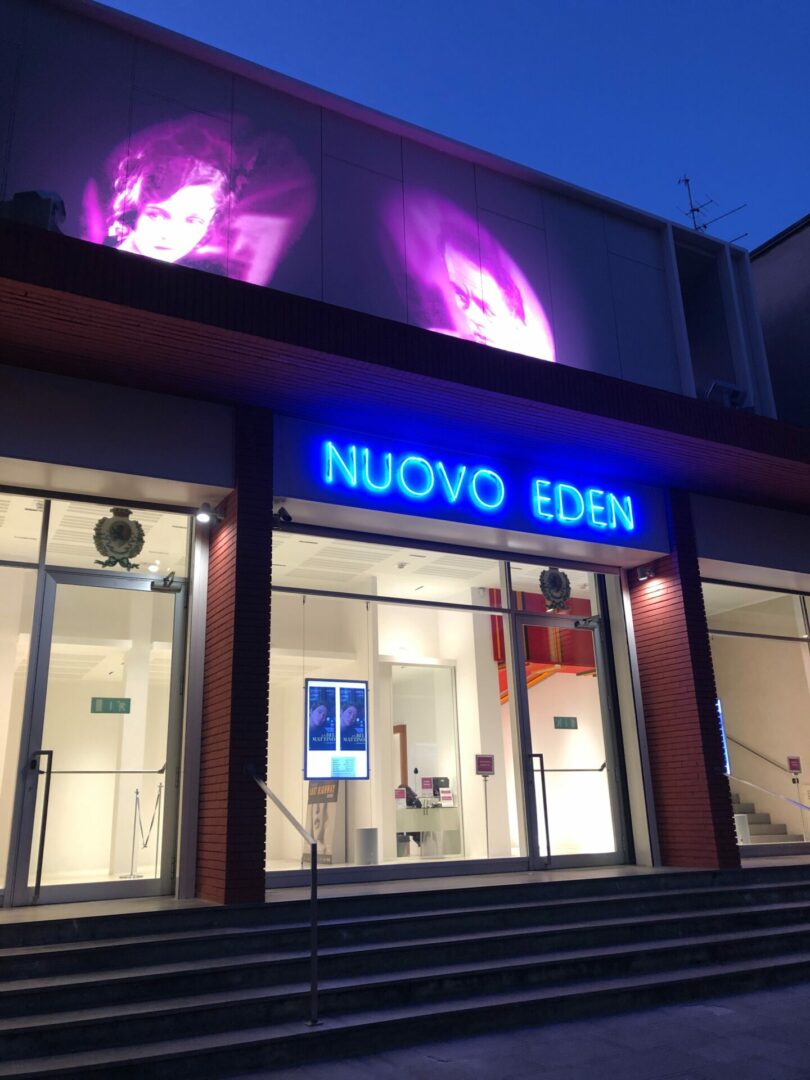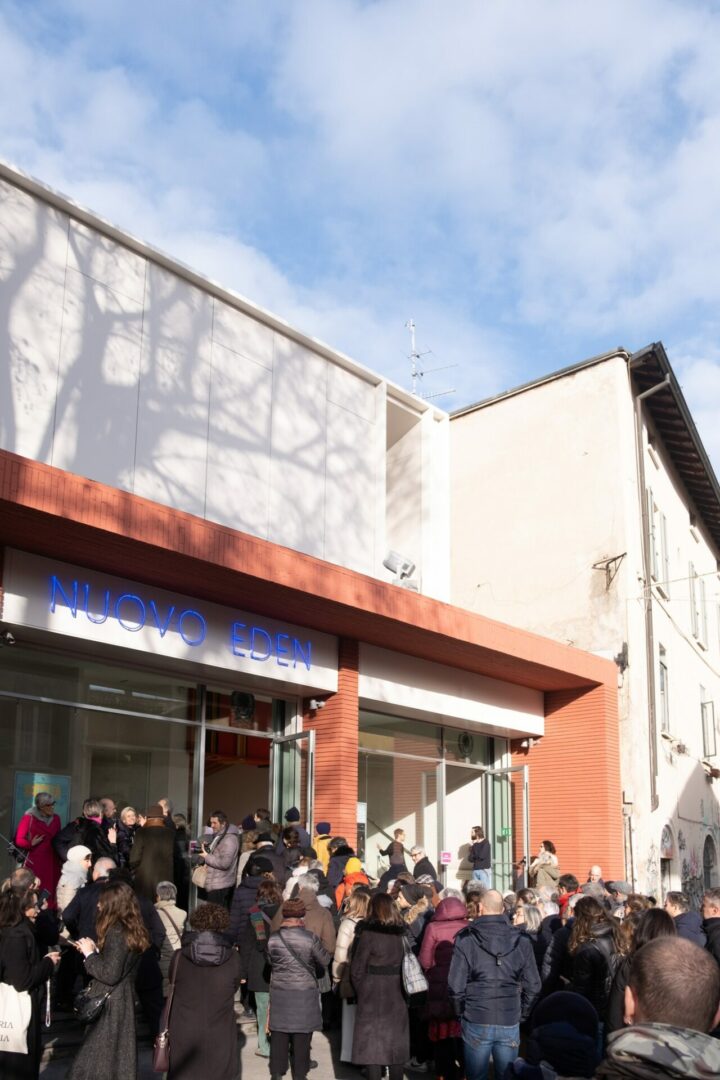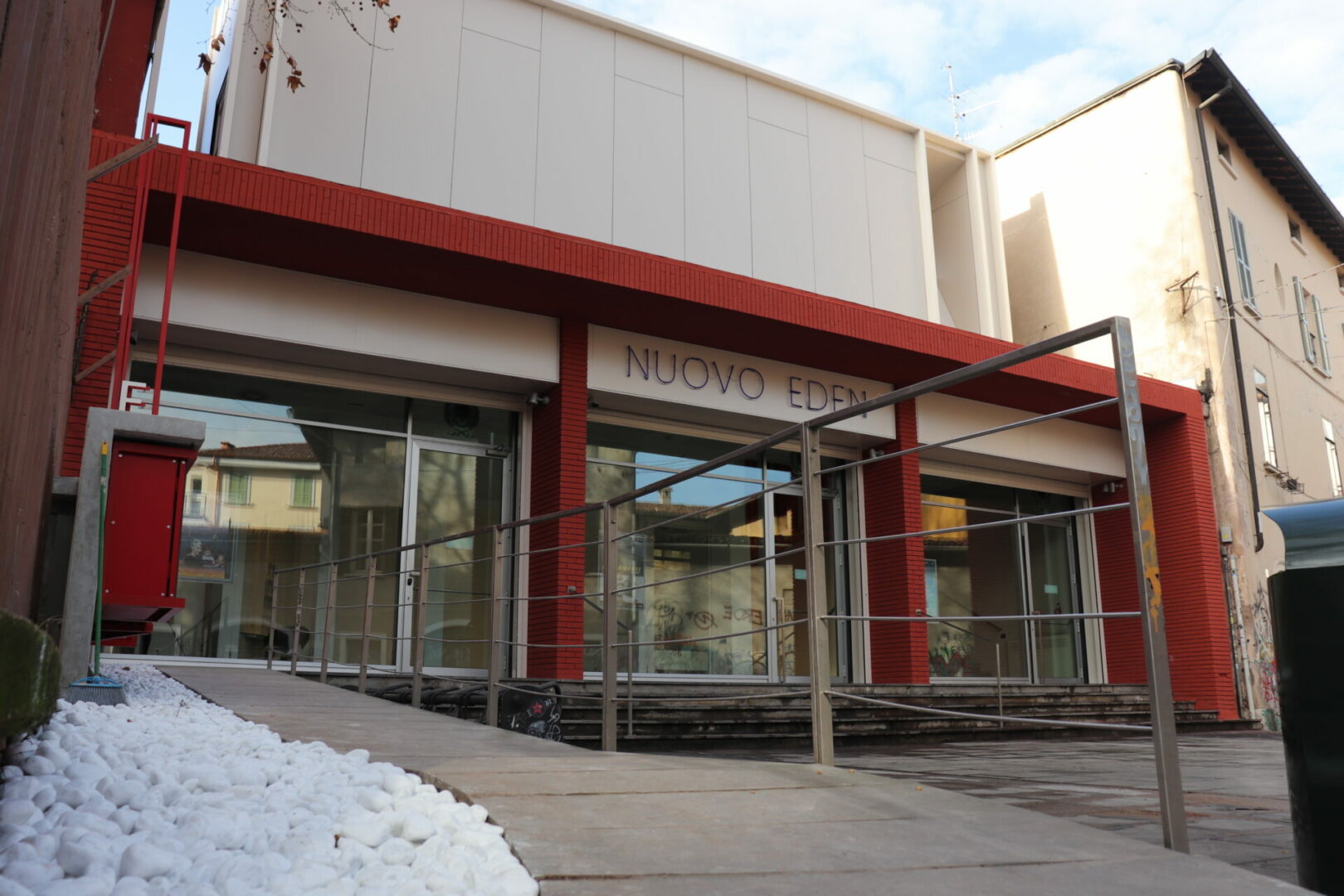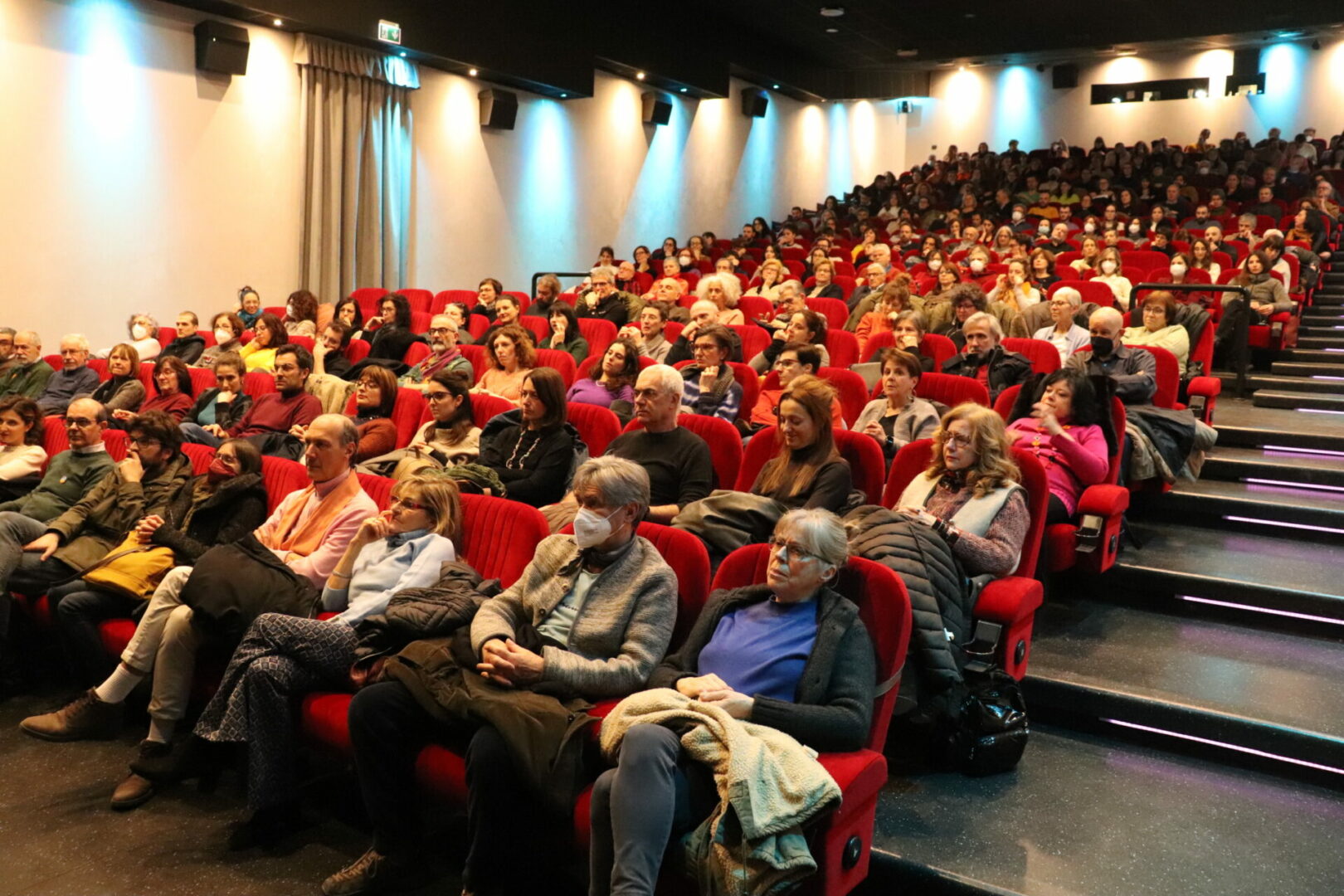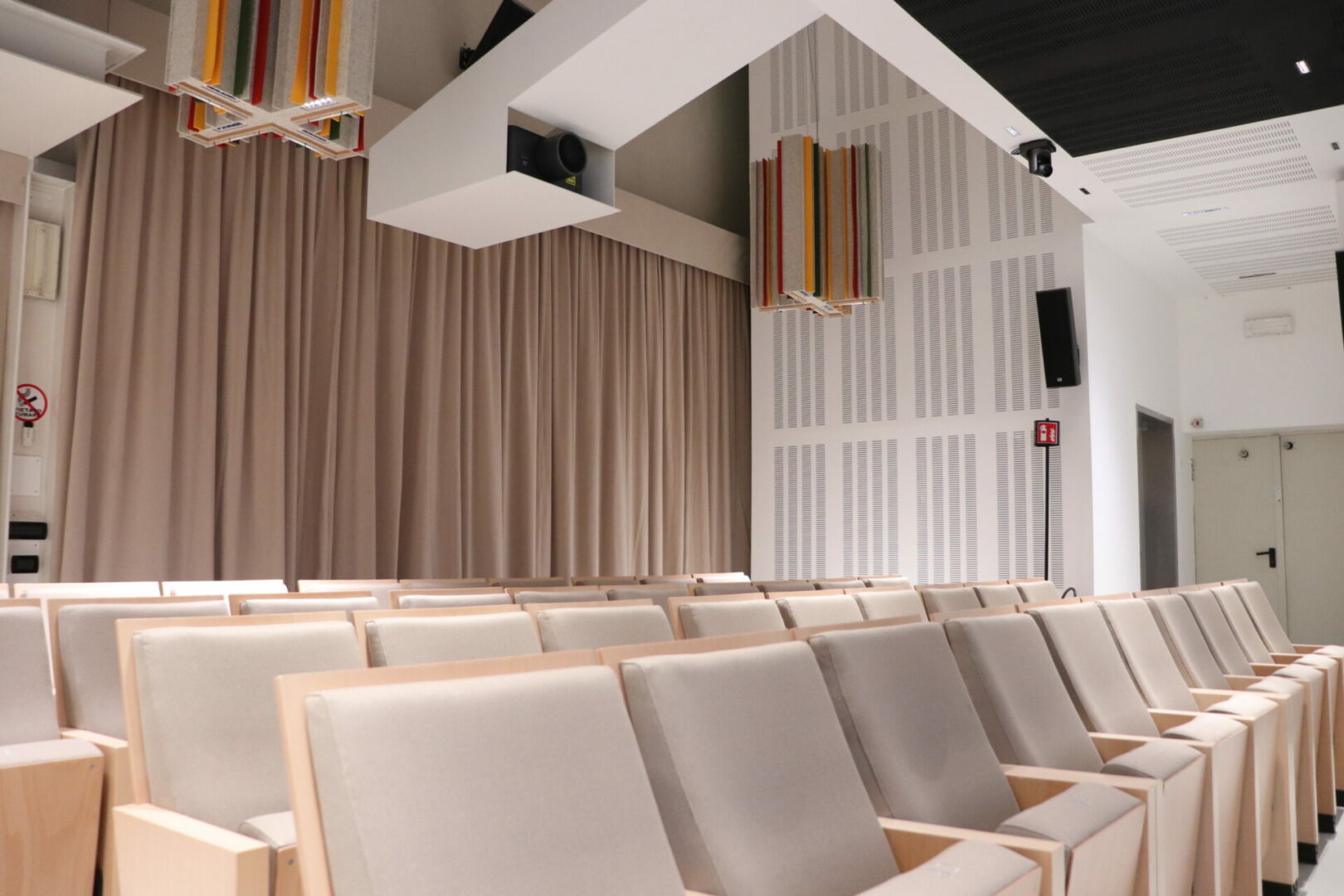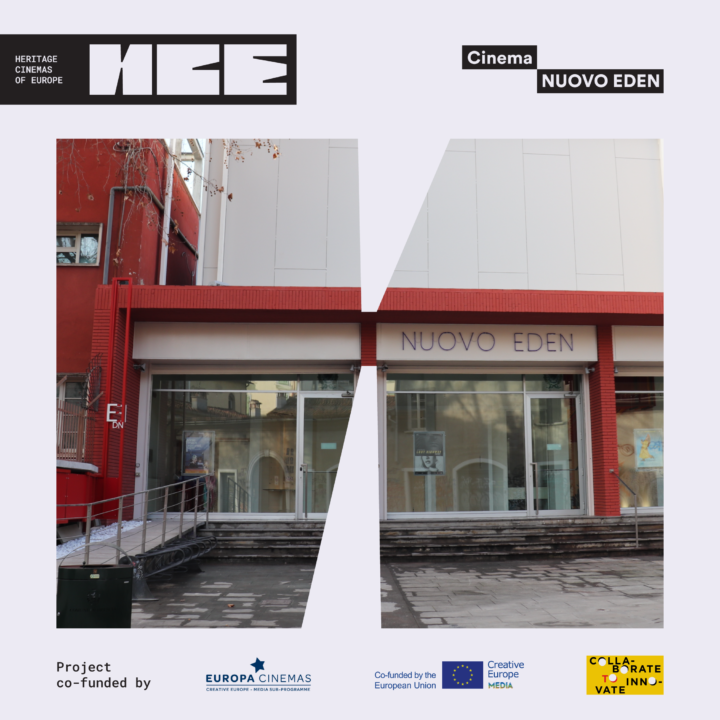Cinema Nuovo Eden
The Cinema
A cinema and more besides.
The arthouse cinema Nuovo Eden, active since 2007, is located in the Carmine district, one of the most beautiful and lively areas of the city’s old town.
Nuovo Eden is managed by the Fondazione Brescia Musei and has been developed thanks to the support of the Municipal Administration.
The Nuovo Eden qualifies as an arthouse cinema and is part of the Europa Cinemas and Heritage Cinemas of Europe European networks.
Nuovo Eden is member of AGIS – Associazione Generale Italiana dello Spettacolo; ANEC – Associazione Nazionale Esercenti Cinema and FICE – Federazione Italiana Cinema d’Essai.
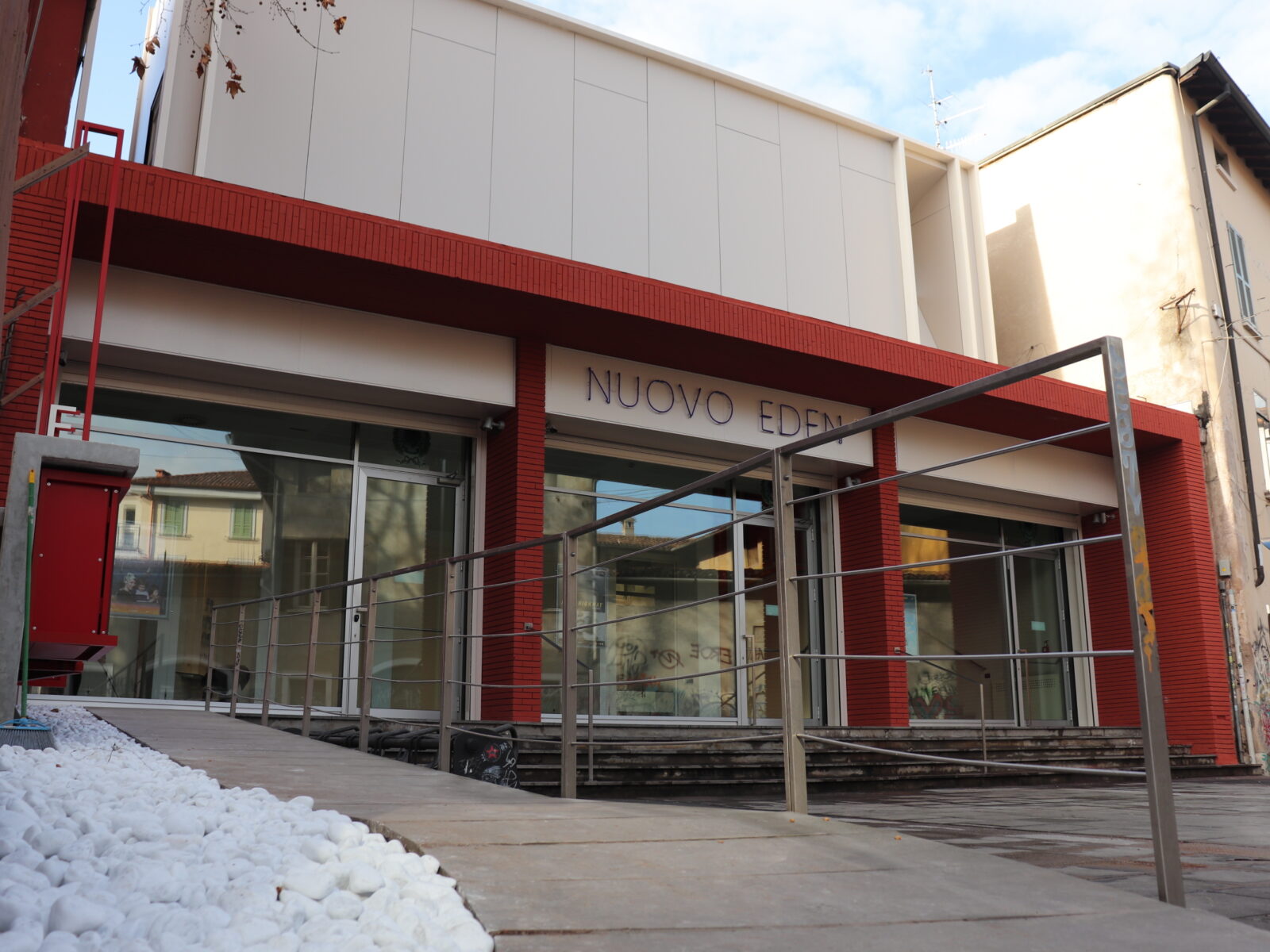
A programme dedicated to arthouse cinema, featuring films by major contemporary authors and independent productions, both Italian and foreign.
Contemporary ‘cinema d’essai’, restored classics from various European and Italian film archives, retrospectives, thematic film reviews dedicated to specific target audiences, collaborations with Italian festivals (Venice, Trieste, Trento, Bergamo, Turin…), ciné-concert, films by emerging local directors, short film festivals and much more.
Cinema and much more: film literacy courses, in-depth seminars with critics and teachers of national standing, School cinema programmes, workshops and films for children, and collaborations with local cultural organisations.
The cinema hall
Historical Information
When you walk down the street that leads down to the front door of the Cinema Nuovo Eden, you can feel you are in a special place in the city of Brescia.
You can feel it in the thousand different languages echoing in the background as you walk, hearing the voices of young people chatting outside the bars near the university, and by taking in the so many diverse architectures that tell a thousand-year old story.
The Cinema Nuovo Eden is in the heart of medieval Brescia, in the Carmine district. And where its auditorium is today, has been a place of aggregation and exchange since the twelfth century. Yesterday and today.
The purchase of the building by the City of Brescia in 2000, its renovation, and its management entrusted to Fondazione Brescia Musei in 2007 have turned this area into a key centre of the city’s cultural offer.
A challenging undertaking, at a time when the cinemas in the city centre were closing one after the other; a project underpinned by an idea that of bring back to life a part of the city’s old historical centre.
The history of the Cinema Nuovo Eden goes back in history: it stands in the area north of Brescia near the ancient city walls that from the Middle Ages until the 1800s guarded and protected the city.
The district in which it stands was founded in the Middle Ages, when the water resources in the area began to be exploited for the processing of materials such as wool and hides, and especially to allow work with water wheels providing unlimited energy for mills and trip hammers.
The area thus became a strong attractor for people seeking the new opportunities that the city, now an autonomous municipality, had to offer.
From its very early days, the Carmine district had the character that still distinguishes it today, an area of cultural vivacity and multi-ethnicity, manifesting in the many workshops and in the different languages and fragrances spreading in the alleys and coming from the open windows and the many bars and restaurants.
It was precisely due to wool processing that the first important structure built on the area of the Cinema Nuovo Eden was erected: its name was the “Casa degli Umiliati da Erbusco”. Built in the thirteenth century, it was a monastic complex of the order of the Umiliati whose work was inspired by highly religious principles of communal life.
Outside the architectural complex that houses the Cinema, the Church of Santi Filippo and Giacomo, remodelled in the nineteenth century, can still be seen, now home to the C.A.R.M.E. contemporary art space.
In 1797, with the Napoleonic lootings, the entire building changed its use and the church was turned into a municipal notarial archive. The monastery complex, on the other hand, as was often the case, was partly used as barracks, since the spaces originally destined to monks could be easily converted into spaces for soldiers.
From the second half of the nineteenth century, the city began to undergo major changes and transformations especially in the area west of the city centre. The new industrial revolution technologies required much larger spaces for the new factories which could no longer be located in the city within the old city walls.
Scientific knowledge and medical science say that hygiene is one of the most important factors in preventing endemic diseases. In the nineteenth century Brescia was sadly known to be very dirty and in 1836 cholera swept the city causing many victims.
This is why the entire poor, malodorous and densely populated medieval Carmine district became the subject of interest of the city’s new master plans, drawn up to decide which areas were to be knocked down in the name of health and progress.
It was not until 1927, when the echoes of World War I had long faded and Italy was ruled by the Fascists, that Brescia adopted its new town-planning scheme, with numerous demolitions in the old city centre being carried out, giving the city a new appearance.
In 1933, the area of the old monastery complex became the centre of a major project. Its 8000 square metres were to be transformed into the new Casa del Balilla (Balilla House) of Brescia by the talented architects Francesco Mansutti and Gino Miozzo from Padua.
The Case del Balilla were unprecedented architectural buildings, representative of the new fascist vision of the world. Not barracks, nor schools, the Case del Balilla were spaces where the principles for the education of fascist youth were taught.
The realisation of the Case del Balilla was underpinned by a precise ideological programme, based on the creation of a network of permanent structures throughout the country.
These were new architectures of which the two architects became the main producers, designing over thirty Balilla Houses across the peninsula.
The Case del Balilla were spaces in which various environments coexisted: reading rooms, gyms, fencing halls, assembly yards, porticoes, offices, outpatient facilities, but above all auditoriums.
It is interesting to note that the projection facilities were included in the auditorium from the very first of the four plans drawn up for the construction of the Casa del Balilla in Brescia. Its position has remained unvaried ever since.
By 1933, the importance and scope of the film medium had been fully acknowledged; so much so that the new architectures designed for the education of young fascists had to necessarily be equipped with the technology to project films.
In 1936 the 500-seat auditorium was completed, along with all the other Casa del Balilla facilities. During the grand inauguration, underlining the importance of having redeveloped a run-down neighbourhood was emphasised in the press.
Screenings open to the public began the following year in the auditorium called GIL Marconi (Gioventù Italiana Littorio, Fascist Italian Youth).
At the end of World War II, the auditorium was still active but in order to separate it from its fascist past it was given the more patriotic and distinctive name of Leonessa, the Lioness. Leonessa d’Italia was the name Brescia had earned for the courage of its men and women during the revolt against the Austrian government in 1849, as the poet Aleardo Aleardi had written in one of his compositions.
The vicissitudes of the cinema, which for a short period went back to its old name Marconi, were similar to those experienced by many other cinemas in old city centres across Italy. In the 1970s, the closure of historic centres to traffic, the oil crisis, television, VHS, and new safety regulations put many cinemas at serious risk of closure.
What saved this particular cinema in Brescia was what today is called public targeting, since in 1981 it became an adult cinema under the name of Cinema Eden, a name chosen as an allusion to a garden of “sexual delights.”
But such a targeted audience going to the cinema throughout the week and not only on weekends, was not enough to keep the budget in order, and in 1999 the cinema had to close for good.
Today the cinema has come back to life and it is much more than a cinema: it is a place of aggregation, culture, and encounter, and a multiplier of ideas and thoughts ideally giving out all the energy gathered in the almost one-thousand-year history of the area on which it stands.
Equipment
The cinema hall is equipped with:
Sala 1 (217 seats):
- 35 mm film projector Prevost
- 2k NEC digital projector
- Dolby Digital sound system
- media players
- 2 wired microphones and 2 wireless microphones.
Sala 2 (38 seats):
- 2k SUPRA digital projector
- Dolby Digital sound system
- media players
- Wi-Fi connection
- 2 wired microphones and 2 wireless microphones.
The Nuovo Eden is wheelchair-friendly.
Request the cinema hall
A space equipped for digital and film screenings.
Nuovo Eden is available for associations, institutions, schools, companies, informal and youth groups, and individuals wishing to organise public or private screenings.
“SALA 1” has 217 seats and a foyer.
“SALA 2” has 38 seats and a foyer.
Costs for each time slot (morning, afternoon or evening):
SALA 1:
- 500 euros + VAT
- 250 euros + VAT (special rate for associations)
SALA 2:
- 300 euros + VAT
- 150 euros + VAT (special rate for associations)
Includes:
- Standard use of the cinema projection equipment
- Utilities
- Ordinary cleaning
- Inspection and event coordination
Does not include:
- No. 2 staff (1 cinema staff and 1 projectionist) at a cost of 25 euros + VAT per hour/person.
- Film copy hire and transport
- SIAE’s fees (Italian society of authors and publishers)
- Hospitality costs for any guests
- Personalised set-up and catering.
For information and bookings:
T. +39 030 8379404 – info@nuovoeden.it
News
Film Screenings
Getting Here
Via Nino Bixio, 9 – Brescia
By Bus and subway
- by bus: lines 2, 7, 15, 17
- by subway: San Faustino stop (towards Prealpino) + 4 minutes on foot
By taxi
Radio Taxi Brixia
tel. (+39) 030.35111
Car parking
- Fossa Bagni, via Lombroso (consigliato)
- Agip, Piazza Vittoria
- Randaccio, via Lupi di Toscana, 2
To visualise all the parking areas and the ZTL areas (zones of restricted circulation) please check the Brescia Mobilità website
To visualise all the accessible parking please check the Brescia Mobilità
Bike Rent
Go to the Brescia Mobilità website to discover this bike service
By Train
Cinema Nuovo Eden can be reached by TreNord (www.trenord.it) and Trenitalia (www.trenitalia.it) regional train services.
From Brescia railway station:
- on foot: 20 minutes following the signs for the centre, then Piazza Vittoria, Piazza Loggia and then the Carmine district.
- by subway: San Faustino stop (towards Prealpino) + 4 minutes on foot
By Plane
Gabriele D’Annunzio Brescia Airport
(20 Km from Brescia)
Orio Al Serio Bergamo Airport
(56 Km from Brescia)
Valerio Catullo Verona Airport
(70 Km from Brescia)
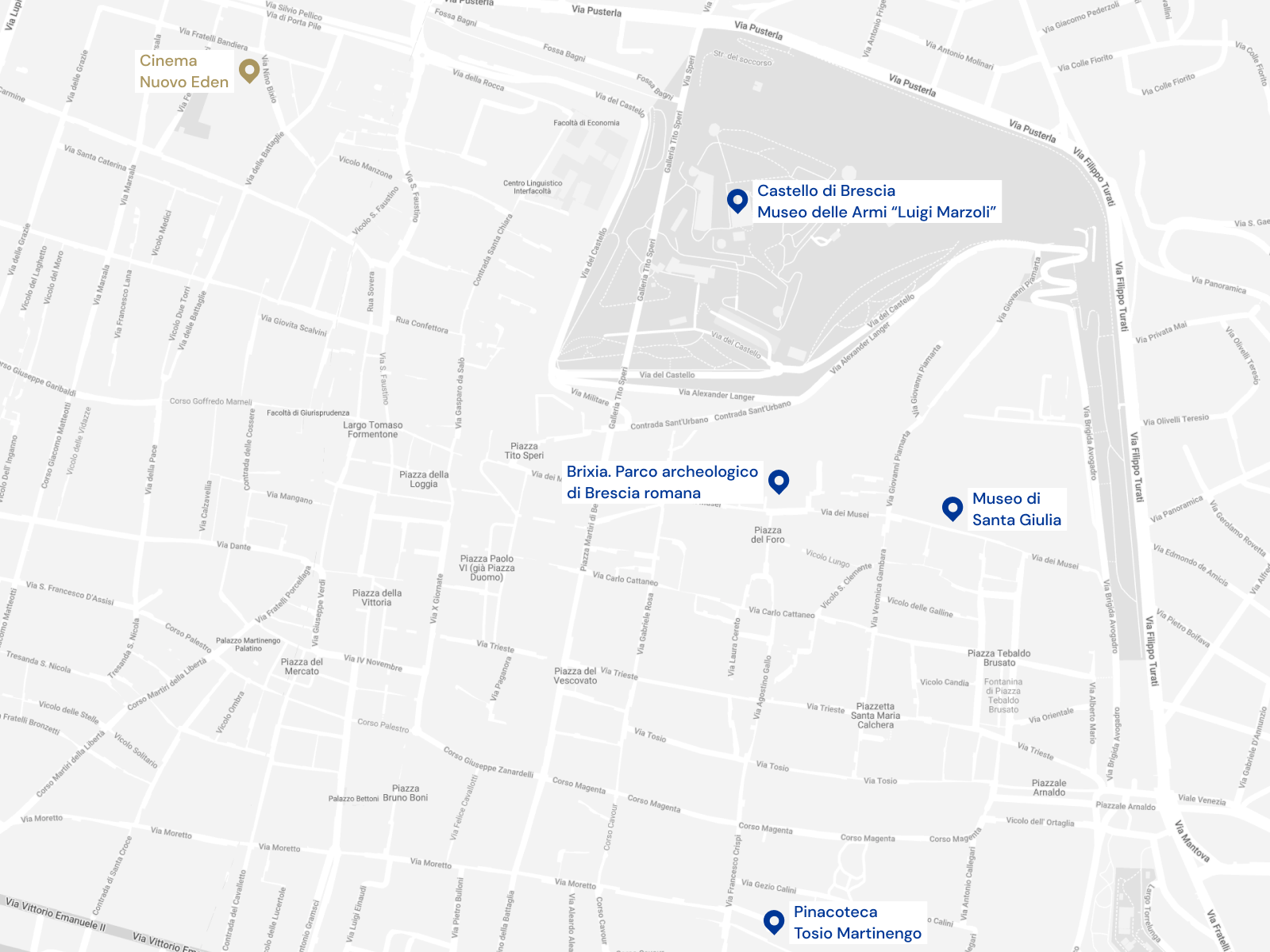
Tickets
Where to buy tickets
Tickets for the screenings can be purchased:
- online (Webtic ticket office)
- on-site at the cinema box office, from 30 minutes before the performance.
If you buy your ticket online, you are entitled to access the fast-track lane.
Discounts
Admission at the reduced price of €5 is valid for:
- Under 14s
- Students under 26
- Over 65s
- Desiderio Card holders
- Io Viaggio (TreNord) card holders
Access conditions
- Compliance with all Covid-19 regulations (hygiene and sanitization) is guaranteed.
- The consumption of food and drink in the auditorium is prohibited.
Contact
Fondazione Brescia Musei – Nuovo Eden
via Nino Bixio, 9 – 25122 Brescia (BS) – Italy
T. +39 030 8174600 – info@nuovoeden.it
Technical Department
Emiliano Treccani – treccanie@bresciamusei.com
Production Department
Clara Massetti – massetti@bresciamusei.com
Valentina Checchi – checchi@bresciamusei.com
R&D and Communication Department
Chiara Boffelli – boffelli@bresciamusei.com
Press Office
Francesca Raimondi – raimondi@bresciamusei.com
Do you want to stay up-to-date on the Nuovo Eden’s activities?


